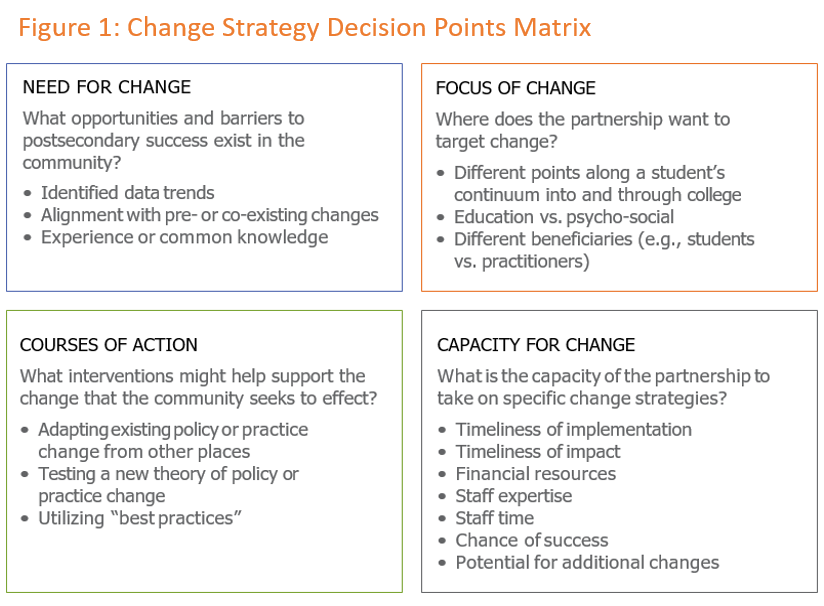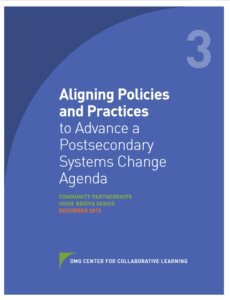Equal Measure and our partners have distilled many highly useful findings for our clients by examining the components of successful place-based systems change investments. For the next few months, we’ll be sharing short, bite-size, and easily digestible elements of these lessons learned through an ongoing series we’re calling Tools & Frameworks.
In 2013, Equal Measure completed a four-year evaluation of the Bill & Melinda Gates Foundation’s Community Partnerships portfolio. We learned valuable lessons on implementing multi-sector strategies to shift local systems to be more effective and equitable. Although the focus in the Gates portfolio was postsecondary attainment, we believe the lessons are applicable across many sectors.
Based on the experiences in the Community Partnerships portfolio, changing the way partners act requires: 1) changing the policies that dictate what organizations and individuals ought to do, and 2) shifting what they actually do by changing practice. Truly shifting systems requires policy and practice alignment built from thoughtful joint planning and shared implementation.
Lesson One:
Develop strategies that enable policy and practice changes to reinforce each other.
Putting Lessons into Practice
- Identify specific policy or practice (often program) changes to undertake.
- Consider the long-term objectives of a particular policy change or program; what is the ultimate goal of making this change or implementing this program?
- Learn from other communities that have engaged in similar policy or practice change efforts: what are successful strategies? What are common pitfalls?
Lesson Two:
Balance the need for “quick wins” with thoughtful change strategies.
Figure 1 below can help guide your decision-making discussions.
Putting Lessons into Practice
- Develop a clear and transparent process to identify change strategies.
- Determine where barriers or opportunities exist (through data trends and partners’ experiences).
- Identify how changing or aligning existing policies and practices reduce or eliminate barriers or open opportunities, and prioritize and sequence both short- and longer-term change efforts.
- Distinguish areas where pent up interest for action exists (e.g., among partners, around a particular issue, because some foundational work has already been done, etc.).
- Pinpoint changes where additional resources are needed: engage in additional research, data collection, and/or conversation and relationship-building to develop policy or practice change strategies.
- Be sure to have the capacity, resources, and relationships in place before developing a policy or practice change strategy — particularly when going for an early win.
- Engage and give credit to partners and predecessors — particularly those who set the stage for early successes.

Lesson Three:
Do not stop at “change”: monitor the implementation and impact of policy and practice changes.
Putting Lessons into Practice
- Identify the expected impact of the policy or program; what are the desired short-term and long-term changes?
- Develop clear expectations about how the policy or practice can lead to impact.
- Establish data collection activities to understand and track implementation and outcomes; use data to develop clear steps to strengthen policy or practice change.
- Consider the intended and unintended consequences of the change; assess whether this information suggests that implementation needs to shift, or whether expectations about outcomes need to shift; include the individuals responsible for carrying out a particular policy or practice change in this assessment process.
- Use data to make the case to leaders to expand or modify change efforts, as needed.
Lesson Four:
Consider how institutions can work together to align policies and practices.
Figure 2 below illustrates approaches to policy and practice change, through examples from the Community Partnerships portfolio. The graphics depict two entities, but more than two entities may be involved in such interactions.
Putting Lessons into Practice
- Elevate areas of change that depend on more than one institution or organization.
- Consider whether existing practices or policies in one organization or institution can be leveraged, or whether something new is needed across partners.
- Draw on approaches from other communities, when possible, to learn from challenges and successes of cross-sector policy and practice change.
- Continue to communicate across partners about policy or practice change, from identification of interventions through implementation.
- Monitor changes to continue to identify opportunities for strengthening alignment and outcomes.

